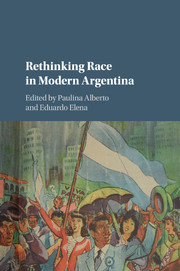Book contents
- Frontmatter
- Contents
- List of figures
- List of tables
- Notes on the contributors
- Preface
- Introduction: The shades of the nation
- PART I HISTORIES OF RACE IN THE TWENTIETH CENTURY
- PART II RACE AND NATION IN THE NEW CENTURY
- 8 African descent and whiteness in Buenos Aires: Impossible mestizajes in the white capital city
- 9 The savage outside of White Argentina
- 10 Between foreigners and heroes: Asian-Argentines in a multicultural nation
- 11 Indias blancas, negros febriles: Racial stories and history-making in contemporary Argentine fiction
- Epilogue: Whiteness and its discontents
- Collective bibliography
- Index
9 - The savage outside of White Argentina
from PART II - RACE AND NATION IN THE NEW CENTURY
Published online by Cambridge University Press: 05 March 2016
- Frontmatter
- Contents
- List of figures
- List of tables
- Notes on the contributors
- Preface
- Introduction: The shades of the nation
- PART I HISTORIES OF RACE IN THE TWENTIETH CENTURY
- PART II RACE AND NATION IN THE NEW CENTURY
- 8 African descent and whiteness in Buenos Aires: Impossible mestizajes in the white capital city
- 9 The savage outside of White Argentina
- 10 Between foreigners and heroes: Asian-Argentines in a multicultural nation
- 11 Indias blancas, negros febriles: Racial stories and history-making in contemporary Argentine fiction
- Epilogue: Whiteness and its discontents
- Collective bibliography
- Index
Summary
In early December 2013, several urban centers in Argentina experienced a wave of turmoil that brought to light the sensibilities that have historically racialized the national geography – a racialization whose existence has long been denied by Argentine official discourse. In the province of Córdoba, thousands of police officers demanded a salary increase by withdrawing from the streets and remaining in their barracks, while undercover officers instigated the looting of stores in order to create a public demand for their presence. The news of the lack of police repression quickly spread, and thousands of men and women from poor neighborhoods began storming stores and supermarkets to grab anything they could, from food to television sets. The unrest spread to other provinces, most notably Tucumán, where the same pattern of a police walkout and subsequent looting unfolded. With several cities shaken by riots, a significant portion of the population felt that the streets were dissolving amid a vortex formed by the expansiveness of los negros [the blacks] – the racialized term used in contemporary Argentina to name the poor and people of indigenous or mestizo [mixed] background.
On the streets as well as in social media and the online forums of Argentine newspapers, thousands of people called for the violent extermination of “esos negros de mierda [those fucking blacks].” Armed vigilantes promptly began shooting at “los negros” as if the latter were savage hordes determined to overrun settlers circling the wagons on a hostile frontier. When La Nación (Argentina's leading conservative newspaper) informed its readers that “a young man” was shot dead in Córdoba, marking the first deadly victim of the violence, most readers posting comments on the paper's online edition celebrated his death as an act of civilizing justice. Many objected to the use of the phrase “a young man” to name what was just a negro. One reader further dehumanized the victim by declaring, “Too bad it's only one. I wish there were two hundred negros dead.” Similar comments flooded Twitter under the hashtag #Negros de mierda. When the violence subsided two days later – after the federal government sent forces to Córdoba and the provincial government there and in Tucumán acquiesced to police demands – over ten people were dead and hundreds were wounded.
- Type
- Chapter
- Information
- Rethinking Race in Modern Argentina , pp. 241 - 267Publisher: Cambridge University PressPrint publication year: 2016
- 34
- Cited by



